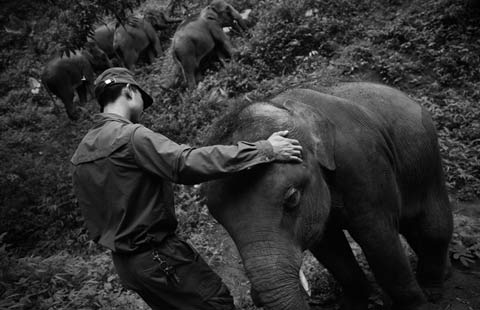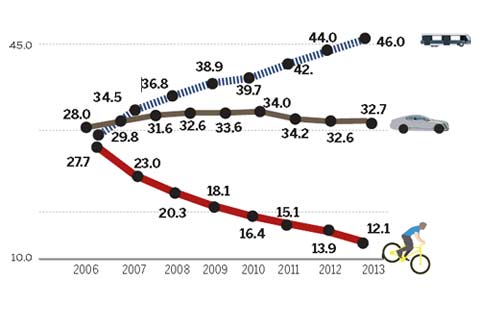General aviation hub reaches for the sky
Updated: 2014-09-17 07:35
By Zhao Lei(China Daily)
|
|||||||||||
|
 |
| An aviation enthusiast experiences the power of a wind tunnel during the Third Shenyang Faku International Flight Show. ZHU XINGXIN / CHINA DAILY |
Pointing to the rows of factories, he proudly announced, "Those facilities belong to companies from the United States, Russia, Italy, and Australia".
Privately owned Chinese businesses are also being encouraged to invest in the park, and the local authorities will help them tap into the market, according to Feng.
"We are determined to transform Faku into the Chinese version of Wichita," he said, referring to the largest city in the US state of Kansas, often called the "air capital of the world" and home to five major aviation companies, including Cessna Aircraft Co, Hawker Beechcraft Corp, and Spirit AeroSystems Inc.
Nationwide boom
As a result of Faku's efforts, Shenyang Aerospace University, one of the nation's leading aviation institutes, has established a number of research and manufacturing facilities in the industrial park.
Yang Fengtian, a member of the Chinese Academy of Engineering and president of the university, said the two-seater RX1E, China's first electric aircraft, will be made in Faku, although no production schedule has yet been released. With a maximum takeoff weight of 480 kilograms and a cruising speed of up to 150 kilometers per hour, the plane can fly for 40 minutes based on a 90-minute charging of each battery.
Easy to maintain, with low operating costs, and eco-friendly, the RX1E is likely to attract huge demand and serve a wide range of purposes, such as police patrols, pilot training, entertainment, and survey mapping services, Yang added.
Feng said Faku will spare no effort to boost research and development of advanced, eco-friendly general aviation aircraft such as the RX1E, and pointed out that construction has started for a 1.2-billion-yuan research and development project by Hebei Soar Aircraft Co.
That investment may appear a huge sum to Feng, but to Lin Zuoming, chairman of the Aviation Industry Corp of China, also known as AVIC, the nation's leading aircraft maker, general aviation-related business means hundreds of billions of yuan, and AVIC has announced that it will establish 50 airparks across China.
The first, in Jingmen, Hubei province, will require investment of almost 10 billion yuan and is projected to take shape before 2019, according to the company inBeijing.
The park will feature aircraft sales services, pilot training schools, aeronautical service facilities, fliers' clubs, and aviation museums.
AVIC plans to make the parks multifunctional platforms that will serve private pilots, boost aviation businesses, disseminate aeronautical knowledge and culture, and promote creative economy in the aircraft industry, according to Tan Ruisong, AVIC's general manager.
In July, the company signed an agreement with the government of Nantong, Jiangsu province, under which it will support the development of general aviation by relocating some of its related businesses in the city.
The aircraft giant is also negotiating with Guizhou province to build a large general aviation base that will include several industrial parks with an overall investment of about 30 billion yuan, it said.
Lin's expansion in the field can be traced back to 2007 when AVIC founded China's first general aviation industrial park in Shaanxi province. The following year, it joined Guangdong province to establish southern China's largest general aviation complex.
Nationwide, more than 100 general aviation industrial parks are already under construction, or are close to construction work beginning, according to Gao Yuanyang, director of the General Aviation Industry Research Center at Beihang University in Beijing.
Obstacles to growth
However, despite the generally upbeat atmosphere, the industry faces many challenges and problems. Wu Tongshui, president of the Civil Aviation University of China, said that although "general aviation fever" has been sweeping the nation and many local governments have plunged into the industry, the current state of play in the sector is in stark contrast to the rosy prospects many people are proclaiming.
"The industry is being hindered by a host of factors, such as the government's tight control of airspace, the absence of relevant laws, and a shortage of general aviation facilities and professionals," he said.
By the end of 2013, there were 1,654 general aviation aircraft on the Chinese mainland, which works out at 13 aircraft for every 10 million people. In Brazil, the figure is 12 times higher, and in the US it is 100 times higher, according to Wu.
"Make a simple comparison of general aviation facilities in the two nations (the US and China) and you will see why the industry in China lags behind other countries," he said, displaying a slew of related data.
The US, which operates more than 300,000 general aviation aircraft, has at least 21,000 airports and landing points for general aviation, and nearly 10,000 maintenance stations.
By contrast, the Chinese mainland has just 290 general aviation airports and landing points, and few maintenance and support facilities.
Similarly, China lacks qualified personnel. By the end of 2015, the country will have at least 2,000 general aviation aircraft, but not enough qualified pilots to fly them, according to Chen Bin, a researcher with the Sino-US joint venture Easyfly Aviation Co.
The industry will see a shortfall of more than 3,000 pilots in the coming five years, and also lacks personnel for operations, ground services, and technical maintenance, he said.
Most of the pilots who graduate from flight academies will join commercial airlines rather than general aviation companies because the commercial outfits are more stable and offer higher rates of pay, he added.
Wang Ya'nan, deputy editor-in-chief of Aerospace Knowledge, said that even if you already have a licensed pilot and a private plane at your disposal, a huge amount of paperwork must be completed before your aircraft can take to the skies.
"First of all, under the current regulations, you need to register your aircraft under the name of an airline, which means you can't legally own an aircraft," he said. "Then when you want to take a flight, you must be patient because the application goes through a slew of complicated and time-consuming review procedures by air traffic control and military authorities."
Despite the Civil Aviation Administration rolling out a series of measures to simplify the approval procedures, aircraft owners still have to apply to the military to use a certain area of airspace and are subject to antiquated rules before they get the green light for each flight.
A Beijing-based businessman who owns two light aircraft said he hasn't registered his planes, and enjoys flying in the loosely monitored airspace.
"I know my flights are regarded as irregular, but a lot of aircraft owners like me don't want to report our flight date, route, takeoff and landing times as well as flight intentions to the authorities every time we want to use our planes," he said, speaking on condition of anonymity.
More support urged
Wu, from the Civil Aviation University of China, said that addressing these obstacles requires greater cooperation and concerted efforts from government departments, the military, aircraft manufacturers and end users.
"Currently, the administrative jurisdiction over the general aviation sector is segmented and overseen by several government bodies, including the National Development and Reform Commission, the Civil Aviation Administration and the General Administration of Sport, and it's not uncommon for their instructions to contradict each other," he said.
Furthermore, China has no laws dedicated to governing and developing the industry, similar to the 1994 General Aviation Revitalization Act in the US. Legislators should consider formulating a specific law to inject momentum to the industry, Wu suggested. He urged the State Council to establish a leading group to focus on the development of general aviation, and to provide more support for domestic businesses in the sector.
The government should take the lead in building general aviation premises because they are usually so expensive, the cost is beyond the range of individuals and enterprises, he said.
The fragmented nature of China's airspace also needs to be reformed to eradicate the problems that plague private enthusiasts and cargo carriers.
Fang Benli, an instructor at the Ruixiang Flight Training Center in Faku, said the center had to dismantle its squadron of Diamond DA40s, Austrian-made single-engine light aircraft, before transporting them to Faku from Binzhou in Shandong province. The planes arrived as parts, were assembled to test their airworthiness and then disassembled before being loaded onto to trains.
"The flight route from the Binzhou to Faku crosses three air traffic control zones, and under the current regulations we would have had to coordinate our plans with all three management bureaus. It's extremely complicated, so we preferred to take the planes apart rather than fly them to Faku."
Liu Ce and Zhang Tongtong in Shenyang contributed to this story.
Please contact the writer at zhaolei@chinadaily.com.cn
Today's Top News
China's door to open wider, Li says
Shanghai FTZ official removed
Actress stuck in nations' conflict
Space-based technology to help deal with disasters
How will Alibaba justify price?
Master Kong pork noodles made with tainted oil
Beijing to tighten foreign hiring requirements
Queen urges Scots to think 'carefully'
Hot Topics
Lunar probe , China growth forecasts, Emission rules get tougher, China seen through 'colored lens', International board,
Editor's Picks

|

|

|

|

|

|





